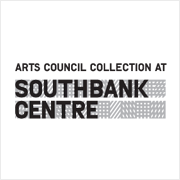Somewhat Abstract: Selections from the Arts Council Collection
- Bridget Riley, Movement in Squares, 1962. Arts Council Collection, Southbank Centre, London © Bridget Riley 2013.
- Wolfgang Tillmans, Dan, 2008. Arts Council Collection, Southbank Centre, London. © the artist, courtesy Maureen Paley, London
Virtually every significant artistic movement since the Second World War is touched on in this major exhibition drawn from The Arts Council’s own national collection, curated by Nottingham Contemporary’s Director Alex Farquharson. Spanning seven decades of art made in Britain, Somewhat Abstract shows the work of 70 artists, eight of them Turner Prize winners.
Abstract art is the exhibition’s starting point. Yet as its title suggests most of the art works are near-abstract, rather than truly abstract. They are works in which the world has undergone a transformation. The image has lost its definition to become something else, while still retaining a sense of where it came from.
Abstract art is generally non-pictorial. The word abstract is also used to describe a thought or theory that is removed from concrete facts and circumstances. This includes the systems, models and diagrams that we use to explain the world, or control it.
For this reason Somewhat Abstract reflects ideas and perspectives outside of art itself. It alludes to nature and landscape, architecture and technology, history and power, modelling and map-making. Its artworks consider social and economic systems, class and gender, bodily experience and existential questions, while the scales it deals with range from the macro to the micro. It includes paint on canvas and bronze sculptures, both staples of earlier abstract art. However it also includes nearabstract photography, together with artworks made from resin, plasticine, pig’s blood, burnt objects – and a computer driven chandelier synced with a morse code monitor, signalling a text by the avant garde musician John Cage through magnificent crystal.
In the mid 20th century abstraction and representation were seen as opposites, with artists forced to take sides. This old distinction no longer holds true, with many contemporary artists moving nimbly in and out of abstraction. Most of the work in this exhibition belongs in the more ambiguous spaces between “isms” familiar from textbook art histories. Abstractions now shape our world, from minimalist architecture to global finance. Even the all pervasive digital image is formed from abstract squares of coloured light, if you get close enough.
Exhibition:
Somewhat Abstract: Selections from the Arts Council CollectionDates:
12 Apr 2014 – 29 Jun 2014Artists:
- Tomma Abts, Armando Andrade Tudela, Frank Auerbach, Francis Bacon, Anna Barriball, David Batchelor, Zarina Bhimji, Karla Black, Peter Blake, David Bomberg, Christine Borland, Martin Boyce, Varda Caivano, Anthony Caro, Helen Chadwick, Adam Chodzko, Prunella Clough, Bernard Cohen, Harold Cohen, Keith Coventry, Cathy De Monchaux, Richard Deacon, Jeremy Deller, Rita Donagh, Garth Evans, Barry Flanagan, Elisabeth Frink, Gilbert and George, Laura Godfrey-Isaacs, Paul Graham, Alexis Harding, Raphael Hefti, Barbara Hepworth, Thurston Hopkins, John Hoyland, Zebedee Jones, Emma Kay, Philip Lai, Peter Lanyon, John Latham, Mark Lewis, Hilary Lloyd, Kenneth Martin, Gustav Metzger, Alan Michael, Yoko Ono, Eduardo Paolozzi, Kathy Prendergast, Bridget Riley, Karin Ruggaber, Colin Self, Walter Sickert, Daniel Sinsel, Lucy Skaer, Richard Smith, Jem Southam, The Hackney Flashers, Wolfgang Tillmans, Amikam Toren, William Tucker, Mark Wallinger, Rebecca Warren, Richard Wentworth, Rachel Whiteread, Cathy Wilkes, Stephen Willats, Cerith Wyn Evans
Curator:
Alex Farquharson
Supported by:
Southbank Centre
Supported by:
